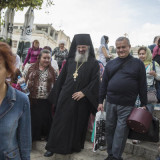HAPPY NEW YEAR???
Again and again, at the end of each year, by the Gregorian calendar we hear the same question repeated: should Christians take part in celebrating the New Year? Do they need to decorate the Christmas tree*? How should they respond to Santa Clause and “snegurochka**”?
Ever since before we can remember, the celebration of New Year was inherited from the nations that filled the earth. However, there was no unison in agreement on the actual date of the New Year. The nations created calendars, connecting their historical events or connecting them with their ancestors. Up until the year of 1699, Russia lived by a chronological calendar from the beginning of the earth. The year started on September 1st. Peter I, by decree of December 15th 1699, established the beginning of the year from January 1st. He also changed the beginning point of chronology, making the beginning point of the new calendar the birth of Christ, which was consistent with the western European calendar. So, in Russia, immediately after December 31st 7208 from the beginning of creation, it was changed to January 1st 1700 from the birth of Christ. We need to keep in mind that Peter I did not know the actual date of Christ’s birth. Also, by the decree of the king, everyone had to decorate their homes on the eve of the New Year with the branches of pine trees. Peter I was not original in his innovation, as, in paganism they used prickly branches in order to scare off the evil spirits, that might ruin their holiday for them. The innovation of Peter I opened the door to other pagan rituals. Then came special foods prepared for these rituals such as crepes, hard-boiled eggs, and special bakery goods. A part of this food, they brought as an offering to the god of fertility. The celebration was accompanied by ceremonial dances, dressed in special clothing, with their faces covered by masks. It is not difficult to notice the connection with today’s masquerades, mass amounts of foods and alcohol beverages at the New Year table.
 Not everyone liked this celebration, for example, Aristotle, who displayed a very negative attitude to the pagan celebration of the New Year calling it “voluntary madness” because often these celebrations would turn into a mass amount of drunken people and led to intoxication. All of this reminds us of orgy, a celebration in honor of the Thracian-Phrygian god of wine, Bacchus, who usually took the form of various excesses, orgies and obscene acts.
Not everyone liked this celebration, for example, Aristotle, who displayed a very negative attitude to the pagan celebration of the New Year calling it “voluntary madness” because often these celebrations would turn into a mass amount of drunken people and led to intoxication. All of this reminds us of orgy, a celebration in honor of the Thracian-Phrygian god of wine, Bacchus, who usually took the form of various excesses, orgies and obscene acts.
About “Santa Clause”, his original name came from Russia, known as “grandfather-treskun”. All too often they just called him grandfather. The people imagined him in the face of an old man with a long white beard, who controlled death with his staff. Over his shoulders, he carried a bag to collect offerings, which later turned into a bag of gifts on the shoulders of Santa Clause (Russian: ded moroz). According to a legend, on the winter solstice, this grandfather needed to be propitiated. In order to gratify him, they would take a young virgin girl and tie her to a tree and left her there to freeze from the bitter frost. If she froze within one day, then it means that the sacrifice was accepted. Eventually the figure of the “grandfather-treskun” transformed into the good and jolly Santa Clause. In the beginning of the 20th century, his image finalized as good, thanks to the famous children’s song “a little pine tree was born in the woods” (Russian folk song), that was written by a poet named Raisa Kudasheva in the year 1903. And the frozen virgin in the woods became known as “snegurochka”
Image wise, much has changed, but the point of the pagan generation still exists. To some, this holiday might seem harmless. What is wrong with a Christmas tree in our home? Toys, lights, candles, this is all very beautiful; this brings up your mood. Everyone is happy, enjoying the time. But I remember an event that is written about in Exodus 32:18-21. They were also joyous and all happy, but in the center of their happiness stood an idol. Few today really think about what lies underneath the sparkle of the “Christmas tinsel”, the sentimental decorations of the Christmas tree and the bright Christmas lights, hiding the far-from-harmless rituals. Right now we can’t be certain where the decorated conifer tree had its origins from. Most of those who investigated this question leaned on the custom that is tied in with the “Christmas” tree, which was born a while back, in the middle of the protesting in Germany, at the end of the 17 century. In other words, the decorated pine tree- is the fruit of the modern times, times of the triumph of rationalism, skepticism and atheism. And it was in this vague time in history, the 17th century, when all of the Eastern Europe began to decorate the Christmas tree.
Each one of us is free to choose, to whom and how we worship; which holidays to celebrate, and what to teach our children. However, I want to point your attention to the fact that neither Yeshua, nor his apostles ever celebrated pagan holidays. They were Jews and lived like Jews, recognizing the holidays of the Lord. Besides this, celebrating the birth of Christ and dancing around a Christmas tree (a pagan tree) looks more like a rebellion then worship to the Lord. Also, I can’t not mention, the actual birth of our Lord was not in December but during the holiday of Sukkot; which the Scriptures testify about. But the 25th of December is dedicated to the pagan god Mitva, and evil mouths proclaimed this day as the day of the “birth of Christ”.
*What is known as the “Christmas tree”, in Russian culture is known as the “New-Year-tree”, and Santa gave gifts on New Year
**Snegurochka- or “the Snow Maiden” is a character of a Russian fairy tale, she is known as the granddaughter of Ded Moroz (Santa Clause/ Father Christmas)










1 Response
[…] In English […]